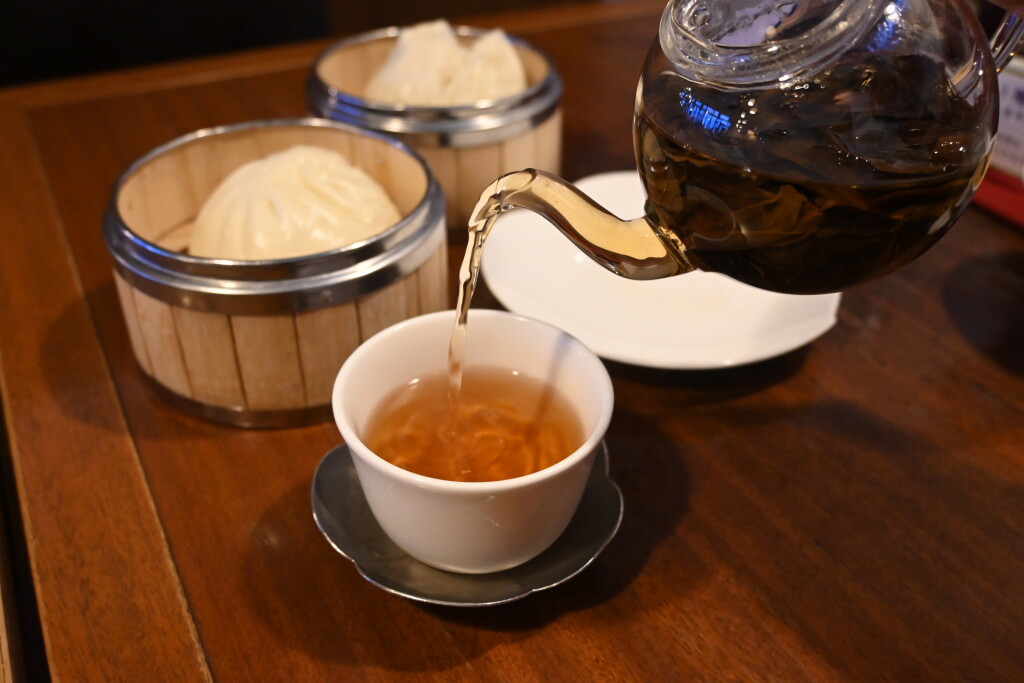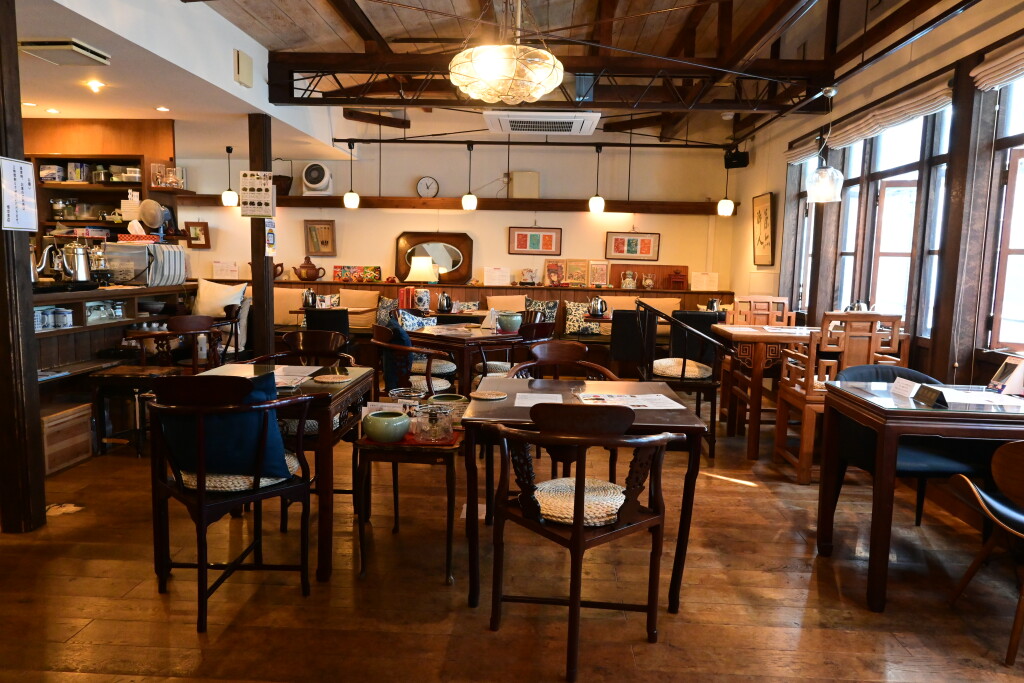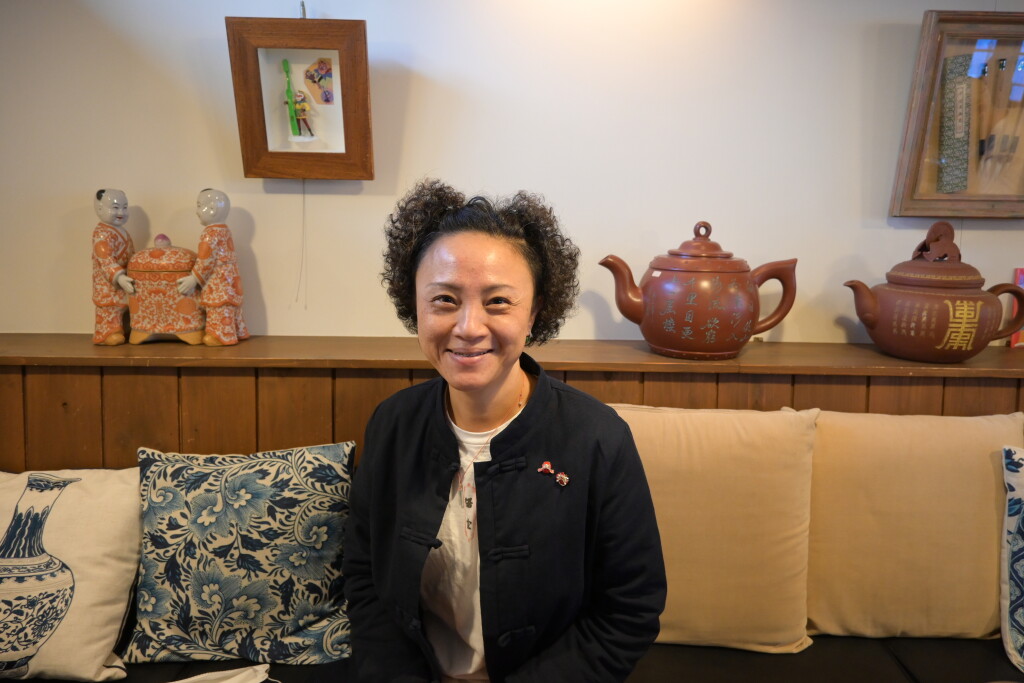A long line of customers forms outside Monkey Magic Teahouse (Goku Chasou in Japanese) just before lunchtime. The establishment located near Kanteibyo Shrine in Yokohama’s Chinatown is celebrating its 20th anniversary. The first floor is a shop selling an extensive array of Chinese tea as well as teapots, cups, ornaments, and other interesting items. The second floor is an attractive teahouse. If you time it right, you can enjoy your tea while taking in live musical performances on traditional instruments. Explore the world of Chinese tea to your heart’s content using all of your five senses in an exotic space that makes you feel like you have been teleported to China.
Ms. Hoin Sou runs Monkey Magic Teahouse as well as the Saikoh Group. Sou was born in Yokohama and grew up in the bustling Chinatown environment, being watched over by the people of its various shops. Her experiences being raised in this vibrant district of commerce gradually led her to develop her own business acumen as an adult. Due to a recent health boom, Chinese tea is now enjoyed by many people, but in the early days of the business, it was not so widely accepted. Times were tough at first. The coming of the COVID-19 pandemic, and consequently the first state of emergency, turned an always busy Chinatown into a ghost town. During that time, Sou spent a lot of time developing new products and preparing for post-pandemic business development. We sat down with this esteemed and naturally cheerful businesswoman with an uncanny ability to turn obstacles into opportunities.
What do you think is so magical/special about tea?
In my opinion, Chinese tea is highly appealing because you can enjoy it anytime, it’s simple to make, and it’s a good value for your money. Japanese people seem to imagine that Chinese tea is difficult to prepare, but Chinese people generally drink tea in a mug. You can drink it for half a day by dropping in the tea leaves just once and continuously adding hot water. You don’t even need a strainer since the tea leaves absorb the water and sink to the bottom. China is a massive country so there are many places of origin, which adds to the fun. Each locale’s background is reflected in the tea’s taste and aroma. All the elements of Chinese tea make it possible to live a life where you can always have it by your side. I think that’s the best part.

Are the tea leaves different? Are the methods to make tea different?
The leaves are essentially the same, but the finishing process is different. People in different regions drink different types of tea: green tea, oolong tea, black tea, and pu’er tea. By the way, 70% of Chinese people drink green tea. Also, some tea is suitable for the local climate or cold weather, green tea is rich in vitamin C, pu’er tea is effective during meals and for dieting, etc. Highly fermented tea like pu’er speeds up metabolism and prevents an upset stomach after meals. Chinese people believe in the concept of ishokudougen (a healthy diet both prevents and cures illness), and approach meals with this thinking. I find that kind of thing very interesting.
Monkey Magic Teahouse is celebrating its 20th anniversary. Congratulations! Could you share some special memories?
Opening in this location was a bit of an adventure. I was looking for somewhere to open a teahouse for a long time. I came across a property under renovation as I was walking near my office. I happened to know the construction worker so I asked him about the building plans. He told me they were converting it into rental units. I asked who the owner was, and it turned out to be another person I knew. I immediately went to the owner and pleaded, “Let me rent this place!” Fortunately, the owner acquiesced. Thus I opened Monkey Magic Teahouse with merchandise sales on the first floor and a cafe space on the second.

Can you tell us about some of the difficulties you have faced in running this business?
In the beginning, it was very difficult to convince people that Chinese tea is a good value for their money and subsequently teach them how to savor its taste. Japanese people are busy so they often can’t spare much time to relax with tea. In China people can spend hours chatting while enjoying their tea time. It is one of the positive aspects of Chinese tea culture, but this was not so familiar to Japanese. In order for people to truly enjoy delicious tea, I take great pains to use quality serving ware and utensils in my store, as well as provide advice to customers on how to properly make tea. As I continued to steadily convey the appeal of Chinese tea, I gradually began to attract more customers.
You also run Saikoh in Chinatown; how is that different from managing Monkey Magic Teahouse?
There isn’t much difference in the management, but the scale is very different. Monkey Magic purchases quality products from China and sells them. I explain thoroughly how to make tea and teach people how to enjoy it. As Saikoh is a restaurant, the cuisine must always be delicious. To this end, the cooks must ensure that there is no inconsistency in seasoning. I do daily tastings and alert them if I sense the food is different from the norm. I also work with the kitchen staff to develop new dishes. What they want to make, what the restaurant thinks should be offered, and the dishes that the customers prefer are all slightly different. I endeavor to express my opinion as a representative of both the restaurant and the customers to develop the best dishes. So I guess I would say cuisine development is the biggest difference in managing the two places.
Please recommend a type of tea from Monkey Magic and a dish from Saikoh, and please tell us why you choose those.
The tea I recommend is Rocha-tekkannon (tie guan yin). This tea from Fujian Province is made by charcoal roasting in the traditional way, which gives it a deep flavor. I also recommend the original blend of Happocha (assorted Chinese herbal tea), which contains eight kinds of medicinal herbs. It is hand-packed in bags. Then, of course, there is our hit product, Hakugakiran (bai ya qi lan). All are available at Monkey Magic. There are many things to recommend at Saikoh. One is the shrimp wafer rolls with mayonnaise, a dim sum dish that we have been serving since the restaurant opened. It’s a very popular dish that some patrons eat several of by themselves. As an appetizer, I’d recommend our pork belly rolls and for a noodle dish try the salty Gomoku soba, which we have been serving for 60 years.
Can you share any interesting insight into Chinatown from your time working there?
This may sound a little strange, but as overseas Chinese, we don’t have what people consider a “hometown”. If asked, “Where is your hometown?” I might answer “Guangdong Province”, where my grandparents were born, but I don’t have a home there, I don’t know anyone there, and I’ve never even been there. As a third-generation Chinese, I was born and raised in Chinatown so this is my true hometown and my roots. The district has changed from the lively Chinatown atmosphere of my childhood to more of a theme park. Regardless, I am very content to have opened a restaurant in this tourist destination. I’m ecstatic when I hear customers from out of town say they will definitely come to my restaurant when they visit Yokohama, even if that is only once a year. Conversely, cooks in Chinatown often stop by on their days off to have dim sum. I think it is unique to Chinatown to be able to meet such customers. Even among Chinatown restaurateurs, if we find something delicious while dining at another’s restaurant, we might ask them to teach us how to make it. It’s like a friendly rivalry in which both parties have a positive influence on each other.
When you have time off, what other Yokohama bars and restaurants do you like to go to?
I like Japanese food and drinks, so I often stroll around the Ishikawa-cho area looking for good places to eat. I think Naka-ku is chock full of Japanese specialty restaurants serving unagi, tonkatsu, and the like, as well as many bars (laughs).


